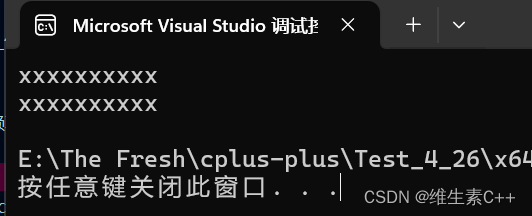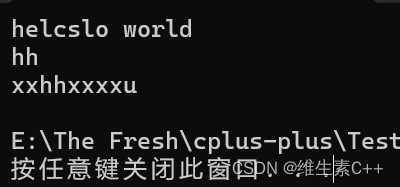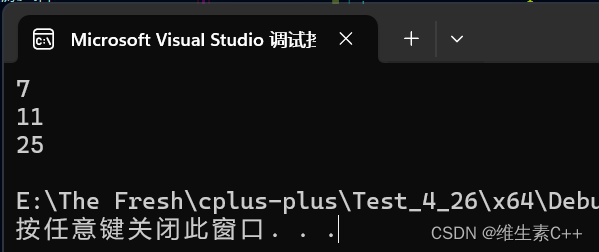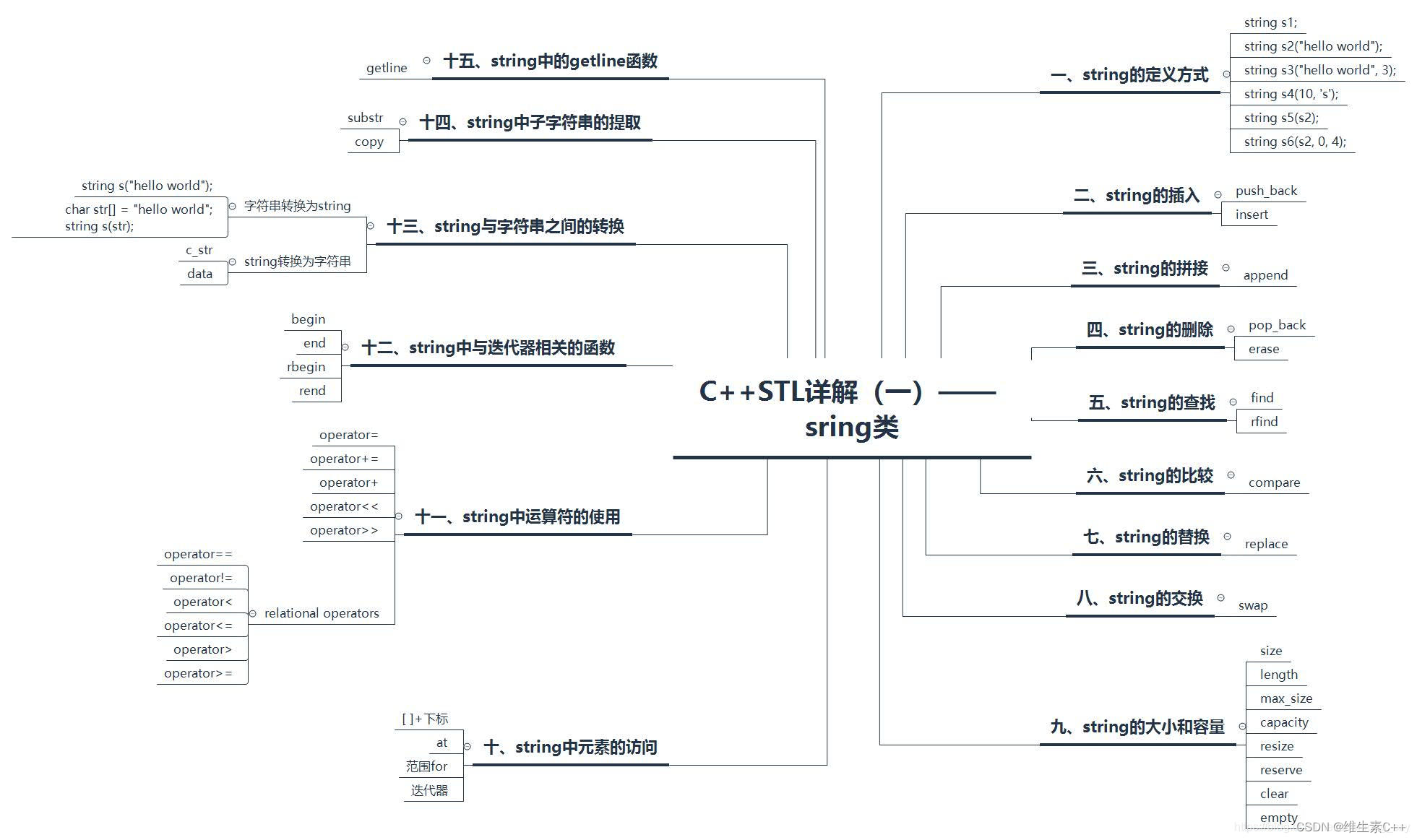文章目录

一、string的定义方式
string类实现了多个构造函数的重载,常用构造函数如下:
string();//构造一个空字符串
string(const string& str);//拷贝str
string(const string & str, size_t pos, size_t len = npos); //从pos位置开始取len个字符拷贝
string(const char* s);//复制s所指的字符序列
string(const char* s, size_t n);//复制s所指的字符序列前n个
string(size_t n, char c);//生成n个c字符构成的字符串
template <class InputIterator>
string(InputIterator first, InputIterator last);//迭代区间构造
使用实例:
string s1;
//构造空字符串
string s2("hello string");
//复制"hello string"
string s3("hello string", 3);
//复制"hello string"的前3个字符
string s4(10, 's');
//生成10个's'字符的字符串
string s5(s2);
//生成s2的复制品
string s6(s2, 0, 4);
//复制s2中从字符位置0开始并跨越4个字符的部分
//通过迭代区间构造string
```cpp
vector<char> v(10, 'x');
for (auto x : v)
{
cout << x;
}
cout << endl;
string s(v.begin(), v.end());
cout << s << endl;
结果:

二、string的插入
- 使用push_back进行尾插
void push_back(char c);
string s;
s.push_back('C');
s.push_back('S');
s.push_back('D');
s.push_back('N');
cout << s << endl; //结果CSDN
- 使用insert插入
string& insert (size_t pos, const string& str);
string& insert (size_t pos, const char* s);
iterator insert (iterator p, char c);
可以发现在pos位置插反而没有,而是迭代器位置插入一个字符,所以本人觉得设计有点搓(STL) 但确实现了这个函数
string& insert (size_t pos, size_t n, char c);
所以可以这样写
string s("hello world");
s.insert(4,1,'M');
string s1("hello world");
s1.insert(3, "cs"); //在pos位置插入一个字符串
string s2("hh");
string s3("xxxxxx");
s3.insert(2, s2); //在pos位置插入一个string
s3.insert(s3.end(), 'u'); //在迭代位置插入一个字符
cout << s1 << endl;
cout << s2 << endl;
cout << s3 << endl;
运行结果:

三、string的拼接
使用append函数完成string的拼接:
string& append (const string& str);
string& append (const char* s);
string& append (size_t n, char c);
#include <iostream>
#include <string>
using namespace std;
int main()
{
string s1("I");
string s2(" like");
//append(string)完成两个string对象的拼接
s1.append(s2); //I like
//append(str)完成string对象和字符串str的拼接
s1.append(" C++"); //I like C++
//append(n, char)将n个字符char拼接到string对象后面
s1.append(3, '!'); //I like C++!!!
cout << s1 << endl; //I like C++!!!
return 0;
}
四、string的删除
void pop_back();
#include <iostream>
#include <string>
using namespace std;
int main()
{
string s("C++");
s.pop_back();
s.pop_back();
cout << s << endl; //C
return 0;
}
2、使用erase删除
string& erase (size_t pos = 0, size_t len = npos);
iterator erase (iterator p);
iterator erase (iterator first, iterator last);
#include<iostream>
using namespace std;
int main()
{
string s("I like C++ !!!");
s.erase(2, 2); //删除从pos位置开始的len个字符
cout << s << endl; //结果
s.erase(s.end() - 1);
cout << s << endl;
s.erase(s.begin() + 1, s.end());
cout << s << endl;
return 0;
}
运行结果:

五、string的查找
1、使用find函数正向搜索第一个匹配项
size_t find (const string& str, size_t pos = 0) const;
size_t find (const char* s, size_t pos = 0) const;
size_t find (char c, size_t pos = 0) const;
#include<iostream>
using namespace std;
int main()
{
string s1("http://www.cplusplus.com/reference/string/string/find/");
//从pos位置开始正向搜索第一个匹配string对象的位置
string s2("www");
size_t pos1 = s1.find(s2,2);
cout << pos1 << endl;
//从pos位置开始正向搜索第一个匹配字符串s3的位置
const char* s3 = "cplus";
size_t pos2 = s1.find(s3,5);
cout << pos2 << endl;
//从pos位置开始正向搜索第一个匹配字符的位置
size_t pos3 = s1.find('r',10);
cout << pos3 << endl;
return 0;
}
运行结果:

2、使用rfind函数反向搜索第一个匹配项
size_t rfind (const string& str, size_t pos = npos) const;
size_t rfind (const char* s, size_t pos = npos) const;
size_t rfind (char c, size_t pos = npos) const;
#include <iostream>
#include <string>
using namespace std;
int main()
{
string s1("http://www.cplusplus.com/reference/string/string/find/");
//rfind(string)反向搜索与string对象所匹配的第一个位置
string s2("string");
size_t pos1 = s1.rfind(s2);
cout << pos1 << endl; //42
//rfind(str)反向搜索与字符串str所匹配的第一个位置
char str[] = "reference";
size_t pos2 = s1.rfind(str);
cout << pos2 << endl; //25
//rfind(char)反向搜索与字符char所匹配的第一个位置
size_t pos3 = s1.rfind('/');
cout << pos3 << endl; //53
return 0;
}
六、string的比较
使用compare函数完成比较:
int compare (const char* s) const;
int compare (size_t pos, size_t len, const char* s) const;
int compare (size_t pos, size_t len, const char* s, size_t n) const;
int compare (const string& str) const;
int compare (size_t pos, size_t len, const string& str) const;
int compare (size_t pos, size_t len, const string& str, size_t subpos, size_t sublen) const;
比较规则:
1、比较字符串中第一个不匹配的字符值较小,或者所有比较字符都匹配,但比较字符串较短,则返回小于0的值。
2、比较字符串中第一个不匹配的字符值较大,或者所有比较字符都匹配,但比较字符串较长,则返回大于0的值。
3、比较的两个字符串相等,则返回0。
#include<iostream>
using namespace std;
#include<string>
int main()
{
string s1("hello world");
string s2("hello CPUlS");
//"hello world"与“hello CPULS"比较
cout << s1.compare(s2) << endl; //1
//”hello”与“hello CPULS”
cout << s1.compare(0, 4, s2) << endl; //-1
//“hello”与“hello”
cout << s1.compare(0, 4, s2, 0, 4) << endl; //0
return 0;
}
**注意:**除了支持string类之间进行比较,compare函数还支持string类和字符串进行比较。
七、string的替换
使用replace函数完成string的替换:
string& replace (size_t pos, size_t len, const char* s);
string& replace (size_t pos, size_t len, size_t n, char c);
#include<iostream>
using namespace std;
int main()
{
string s1("hello world");
s1.replace(0,2,"xx"); //xxllo world
cout<<s1<<endl;
s1.replace(2,1,3,'c');
cout<<s1<<endl; //xxccclo world
return 0;
}
八、string的交换
使用swap函数完成两个string类的交换:
void swap (string& x, string& y);
void swap (string& str);
#include<iostream>
using naemspace std;
int main()
{
string s1("hello world");
string s2("hello csdn");
s1.swap(s2);
cout<<s1<<endl; //hello csdn
cout<<s2<<endl; //hello world
return 0;
}
九、string的大小和容量
1、使用size函数或length函数获取当前有效字符的个数
size_t size() const;
size_t length() const;
#include<iostream>
using namespace std;
int main()
{
string s("hello world");
cout<<s.size()<<endl; //11
cout<<s.length()<<endl; //11
return 0;
}
注意:size和length效果一样,以后基本上使用size()因为这个单词意思更加符合,链表称为length长度就不太合理了
2、使用max_size函数获取string对象对多可包含的字符数
size_t max_size() const;
#include<iostream>
using namespace std;
int main()
{
string s("hello world");
cout << s.max_size() << endl; //9223372036854775807
return 0;
}
3、使用capacity函数获取当前对象所分配的存储空间的大小,即存储有效字符的容量
size_t capacity() const;
#include<iostream>
using namespace std;
int main()
{
string s("hello");
cout << s.capacity() << endl; //15
return 0;
}
4、使用resize改变当前对象的有效字符的个数
void resize (size_t n);
void resize (size_t n, char c);
resize规则:
- 当n大于对象当前的size时,将size扩大到n,扩大的字符为c,若c未给出,则默认为’\0’。
- 当n小于对象当前的size时,将size缩小到n。
#include<iostream>
using namespace std;
#include<string>
int main()
{
string s1("CSDN");
cout << s1 << endl; //CSDN
cout << s1.size() << endl; //4
cout << s1.capacity() << endl; //15
//1.resize(n)n大于对象当前的size时,n>capacity先扩容,后将将size扩大到n,扩大的字符默认为'\0'
s1.resize(20);
cout << s1 << endl; //CSDN
cout << s1.size() << endl; //20
cout << s1.capacity() << endl; //31
string s2("CSDN");
//2.resize(n)n大于对象当前的size时,n>capacity先扩容,后将将size扩大到n,扩大的字符为'x'
s2.resize(20,'x');
cout << s2 << endl; //CSDNxxxxxxxxxxxxxxxx
cout << s2.size() << endl; //20
cout << s2.capacity() << endl; //31
//resize(n)n小于对象当前的size时,将size缩小到n
string s3("CSDN");
s3.resize(2);
cout << s3 << endl; //CS
cout << s3.size() << endl; //2
cout << s3.capacity() << endl; //15
return 0;
}
**注意:**当n>capacity时会先扩容,再resize到n。
5、使用reserve改变当前对象的容量大小
void reserve (size_t n = 0);
reserve规则:
- 当n大于对象当前的capacity时,将capacity扩大到n或大于n。
- 当n小于对象当前的capacity时,什么也不做(取决于编译器)。
#include <iostream>
#include <string>
using namespace std;
int main()
{
string s("CSDN");
cout << s << endl; //CSDN
cout << s.size() << endl; //4
cout << s.capacity() << endl; //15
//reverse(n)当n大于对象当前的capacity时,将当前对象的capacity扩大为n或大于n
s.reserve(20);
cout << s << endl; //CDSN
cout << s.size() << endl; //4
cout << s.capacity() << endl; //31
//reverse(n)当n小于对象当前的capacity时,什么也不做
s.reserve(2);
cout << s << endl; //CDSN
cout << s.size() << endl; //4
cout << s.capacity() << endl; //31
return 0;
}
注意:此函数对size没有影响,不会影响数据,当n小于对象时vs一般不缩容,g++linux下可能缩容,但也是缩到>=size,不会影响数据,具体还是取决于编译器
6、使用clear删除对象的内容,删除后对象变为空字符串
void clear();
int main()
{
string s("CSDN");
//清空字符串
s.clear();
cout << s << endl; //变成了空串
return 0;
}
7、使用empty判断对象是否为空
bool empty() const;
#include<iostream>
using namespace std;
#include<string>
int main()
{
string s("CSDN");
cout << s.empty() << endl; //0
//清空字符串
s.clear();
cout << s.empty() << endl; //1 清空后判断为空 返回true
return 0;
}
十、string中元素的访问
1、[ ]+下标
因为string类对[ ]运算符进行了重载,所以我们可以直接使用[ ]+下标访问对象中的元素。并且该重载使用的是引用返回,所以我们可以通过[ ]+下标修改对应位置的元素。
char& operator[] (size_t pos);
const char& operator[] (size_t pos) const;
#include<iostream>
using namespace std;
#include<string>
int main()
{
string s("hello world");
for (int i = 0; i < s.size(); i++)
{
cout << s[i]; //hello world
}
cout << endl;
for (int i = 0; i < s.size(); i++)
{
s[i] = 'x';
}
cout << s << endl; //xxxxxxxxxxx
return 0;
}
2、使用at访问对象中的元素
因为at函数也是使用的引用返回,所以我们也可以通过at函数修改对应位置的元素。
char& at (size_t pos);
const char& at (size_t pos) const;
#include<iostream>
using namespace std;
#include<string>
int main()
{
string s("hello world");
for (int i = 0; i < s.size(); i++)
{
cout << s.at(i); hello world
}
cout << endl;
for (int i = 0; i < s.size(); i++)
{
s.at(i) = 'x';
}
cout << s << endl; //xxxxxxxxxxx
return 0;
}
3、使用范围for访问对象中的元素
需要特别注意的是:若是需要通过范围for修改对象的元素,则用于接收元素的变量e的类型必须是引用类型,否则e只是对象元素的拷贝,对e的修改不会影响到对象的元素。
#include<iostream>
using namespace std;
#include<string>
int main()
{
string s("hello world");
for (auto e : s)
{
cout << e; //hello world
}
cout << endl;
for (auto& e : s)
{
e = 'x';
}
cout << s << endl; //xxxxxxxxxxx
return 0;
}
4、使用迭代器访问对象中的元素
#include<iostream>
using namespace std;
#include<string>
int main()
{
string s("hello world");
string::iterator it1 = s.begin();
while (it1 != s.end())
{
cout << (*it1); //world
it1++;
}
cout << endl;
string::iterator it2 = s.begin();
while (it2 != s.end())
{
(*it2) = 'x';
it2++;
}
cout << s << endl; //xxxxxxxxxxx
return 0;
}
十一、string中运算符的使用
1、operator=
string& operator= (const string& str);
string& operator= (const char* s);
string& operator= (char c);
string类中对=运算符进行了重载,重载后的=运算符支持string类的赋值、字符串的赋值以及字符的赋值。
#include<iostream>
using namespace std;
#include<string>
int main()
{
string s1;
string s2("hello world");
s1 = s2;
cout << s1 << endl; //hello world
s1 = "CSDN";
cout << s1 << endl; //CSDN
s1 = 'x';
cout << s1 << endl; //x
return 0;
}
2、operator+=
string& operator+= (const string& str);
string& operator+= (const char* s);
string& operator+= (char c)
#include<iostream>
using namespace std;
#include<string>
int main()
{
string s1("hello");
string s2("xx");
s1 += s2;
cout << s1 << endl; //helloxx
s1 += "hh";
cout << s1 << endl; //helloxxhh
s1 += 'd';
cout << s1 << endl; //helloxxhhd
return 0;
}
3、operator+
string operator+ (const string& lhs, const string& rhs);
string operator+ (const string& lhs, const char* rhs);
string operator+ (const char* lhs, const string& rhs);
string operator+ (const string& lhs, char rhs);
string operator+ (char lhs, const string& rhs);
string类中对+运算符进行了重载,重载后的+运算符支持以下几种类型的操作:
string类 + string类
string类 + 字符串
字符串 + string类
string类 + 字符
字符 + string类
它们相加后均返回一个string类对象。
#include <iostream>
#include <string>
using namespace std;
int main()
{
string s;
string s1("super");
string s2("man");
const char* str = "woman";
char ch = '!';
//string类 + string类
s = s1 + s2;
cout << s << endl; //superman
//string类 + 字符串
s = s1 + str;
cout << s << endl; //superwoman
//字符串 + string类
s = str + s1;
cout << s << endl; //womansuper
//string类 + 字符
s = s1 + ch;
cout << s << endl; //super!
//字符 + string类
s = ch + s1;
cout << s << endl; //!super
return 0;
}
4、operator>> 和 operator<<
string类中也对>>和<<运算符进行了重载,这就是为什么我们可以直接使用>>和<<对string类进行输入和输出的原因。
istream& operator>> (istream& is, string& str);
ostream& operator<< (ostream& os, const string& str);
#include <iostream>
#include <string>
using namespace std;
int main()
{
string s;
cin >> s; //输入
cout << s << endl; //输出
return 0;
}
5、relational operators
string类中还对一系列关系运算符进行了重载,它们分别是==、!=、<、<=、>、>=。重载后的关系运算符支持string类和string类之间的关系比较、string类和字符串之间的关系比较、字符串和string类之间的关系比较。
bool operator== (const string& lhs, const string& rhs);
bool operator== (const char* lhs, const string& rhs);
bool operator== (const string& lhs, const char* rhs);
bool operator!= (const string& lhs, const string& rhs);
bool operator!= (const char* lhs, const string& rhs);
bool operator!= (const string& lhs, const char* rhs);
bool operator< (const string& lhs, const string& rhs);
bool operator< (const char* lhs, const string& rhs);
bool operator< (const string& lhs, const char* rhs);
bool operator<= (const string& lhs, const string& rhs);
bool operator<= (const char* lhs, const string& rhs);
bool operator<= (const string& lhs, const char* rhs);
bool operator> (const string& lhs, const string& rhs);
bool operator> (const char* lhs, const string& rhs);
bool operator> (const string& lhs, const char* rhs);
bool operator>= (const string& lhs, const string& rhs);
bool operator>= (const char* lhs, const string& rhs);
bool operator>= (const string& lhs, const char* rhs);
#include <iostream>
#include <string>
using namespace std;
int main()
{
string s1("abcd");
string s2("abde");
cout << (s1 > s2) << endl; //0
cout << (s1 < s2) << endl; //1
cout << (s1 == s2) << endl; //0
return 0;
}
注意:这些重载的关系比较运算符所比较的都是对应字符的ASCII码值。
十二、string中与迭代器相关的函数
1、与正向迭代器相关的函数
begin函数:返回一个指向字符串第一个字符的迭代器。
函数原型:
iterator begin();
const_iterator begin() const;
end函数:返回一个指向字符串结束字符的迭代器,即’\0’。
iterator end();
const_iterator end() const;
使用示例:
#include <iostream>
#include <string>
using namespace std;
int main()
{
string s("hello string");
//正向迭代器
string::iterator it = s.begin();
while (it != s.end())
{
cout << *it;
it++;
}
cout << endl; //hello string
return 0;
}
2、与反向迭代器相关的函数
rbegin函数:返回指向字符串最后一个字符的反向迭代器。
reverse_iterator rbegin();
const_reverse_iterator rbegin() const;
rend函数:返回指向字符串第一个字符前面的理论元素的反向迭代器。
reverse_iterator rend();
const_reverse_iterator rend() const;
使用示例:
#include <iostream>
#include <string>
using namespace std;
int main()
{
string s("hello string");
//反向迭代器
string::reverse_iterator rit = s.rbegin();
while (rit != s.rend())
{
cout << *rit;
rit++;
}
cout << endl; //gnirts olleh
return 0;
}
十三、string与字符串以及整形其它类型的转换之间的转换
1、将字符串转换为string
#include <iostream>
#include <string>
using namespace std;
int main()
{
//方式一
string s1("hello world");
//方式二
char str[] = "hello world";
string s2(str);
cout << s1 << endl; //hello world
cout << s2 << endl; //hello world
return 0;
}
2、使用c_str或data将string转换为字符串
const char* c_str() const;
const char* data() const;
在C++98中,c_str()返回 const char* 类型,返回的字符串会以空字符结尾。
在C++98中,data()返回 const char* 类型,返回的字符串不以空字符结尾。
但是在C++11版本中,c_str()与data()用法相同。
#include <iostream>
#include <string>
using namespace std;
int main()
{
string s("hello world ");
const char* str1 = s.data();
const char* str2 = s.c_str();
cout << str1 << endl;
cout << str2 << endl;
return 0;
}
3、将整形及其他类型转为string,string转为整形等
to_string
string to_string (int val);
string to_string (long val);
string to_string (long long val);
string to_string (unsigned val);
string to_string (unsigned long val);
string to_string (unsigned long long val);
string to_string (float val);
string to_string (double val);
string to_string (long double val);
#include<iostream>
using namespace std;
#include<string>
int main()
{
string s1 = to_string(112);
cout << s1 << endl; //"112"
string s2 = to_string(112.220);
cout << s2 << endl; //"112.220"
return 0;
}
stoi将string转为int形
#include<iostream>
using namespace std;
#include<string>
int main()
{
string s = "1111";
int c = stoi(s);
cout << c << endl; //1111
return 0;
}
十四、string中子字符串的提取
1、使用substr函数提取string中的子字符串
string substr (size_t pos = 0, size_t len = npos) const;
#include <iostream>
#include <string>
using namespace std;
int main()
{
string s1("abcdef");
string s2;
//substr(pos, n)提取pos位置开始的n个字符序列作为返回值
s2 = s1.substr(2, 4);
cout << s2 << endl; //cdef
return 0;
}
2、使用copy函数将string的子字符串复制到字符数组中
size_t copy (char* s, size_t len, size_t pos = 0) const;
#include <iostream>
#include <string>
using namespace std;
int main()
{
string s("abcdef");
char str[20];
//copy(str, n, pos)复制pos位置开始的n个字符到str字符串
size_t length = s.copy(str, 4, 2);
//copy函数不会在复制内容的末尾附加'\0',需要手动加
str[length] = '\0';
cout << str << endl; //cdef
return 0;
}
十五、string中的getline函数
我们知道,使用>>进行输入操作时,当>>读取到空格便会停止读取,基于此,我们将不能用>>将一串含有空格的字符串读入到string对象中。
#include <iostream>
#include <string>
using namespace std;
int main()
{
string s;
cin >> s; //输入:hello CSDN
cout << s << endl; //输出:hello
return 0;
}
这时,我们就需要用getline函数完成一串含有空格的字符串的读取操作了。
用法一
istream& getline (istream& is, string& str);
getline函数将从is中提取到的字符存储到str中,直到读取到换行符’\n’为止。
#include <iostream>
#include <string>
using namespace std;
int main()
{
string s;
getline(cin, s); //输入:hello CSDN
cout << s << endl; //输出:hello CSDN
return 0;
}
用法二
istream& getline (istream& is, string& str, char delim);
#include <iostream>
#include <string>
using namespace std;
int main()
{
string s;
getline(cin, s, 'D'); //输入:hello CSDN
cout << s << endl; //输出:hello CS
return 0;
}
























 143
143











 被折叠的 条评论
为什么被折叠?
被折叠的 条评论
为什么被折叠?










